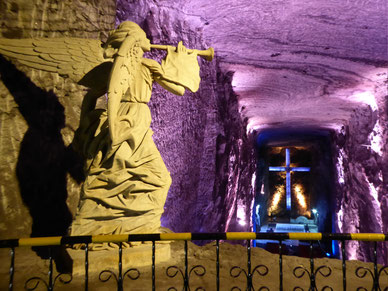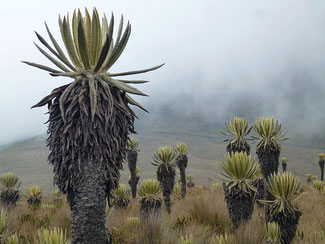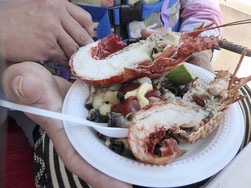
Travelers I've met have often raved about Colombia. So I always wanted to get to know this country and since it was no longer so dangerous to travel the beautiful country and also had the opportunity to explore together with the girlfriend of my deceased son, was not a trip in the way.
The Colombians are very, very friendly and helpful. They are glad that now so many tourists visit their country and the fruitful times of the civil war are over.
Bogotá

Bogotá is the capital of Colombia with almost 7 million inhabitants. Ascending the Sunset Cable Car from the Santa Fe District to the 3152-meter-high Cerro de Monserrate offers spectacular views of the city.
La Candelaria
La Candelaria is the city's historic and cultural center, with cobblestone streets, serene squares and colorfully painted houses testifying to its colonial
heritage. La Candelaria is one of the best preserved historic old towns in Latin America. The district has a rich cultural life. Numerous libraries theaters and museums exist. It is also home to
many universities and government agencies. Due to its attractiveness as a bohemian district of Bogotá, La Candelaria is a popular gathering place for intellectual fringe groups with predominantly
literary, visual and musical activity or ambition, and attracts many visitors throughout the year. This is where the heart of nightlife beats and you are right in the heart of Bogotá. That's why
it makes sense to look for accommodation here.
Plaza Chorro de Quevedo and surroundings
We did a free guided tour of Bogotá (free walking tour) which starts at 10 o'clock in the morning from Plaza Chorro de Quevedo (yellow parasol). And that's all:
1. Meeting point and informational: Chorro de Quevedo
2. Beverage cup of the Colombian beverage: Chicha (lightly alcoholic maistrunk
the Andean countries)
3. Visit and explanation of the Graffiti Tour in the street "Funnel"
4. Declaration and food of the Colombian fruits.
5. Declaration and feeding of coca leaves
6. Information about Emerald Classification
7th visit to the Plaza de Santander
8th visit to the Plaza de Bolivar
9. Coffee-tasting
Plaza de Bolivar

Plaza de Bolivar is the central square of the Colombian capital Bogotá in the district of La Candelaria. The square is surrounded by historic buildings and houses a statue of Simon Bolivar.
Museo de Oro - Gold museum

The collection of pre-Columbian gold objects is unique in the world and is considered the largest of its kind (35,000 pieces). The exhibits also include objects made of clay, stone, shells, wood and textiles.
Museo Botero

The Museo Botero bears the name of the most famous Colombian artist, painter and sculptor Fernando Bolero. The museum holds a collection of artworks boleros, including paintings drawings and sculptures. There are also paintings by famous international artists such as Salvador Dalí and Pablo Picasso.
Admission is free!
Salt Cathedral in Zapaquirá
From Bogotá we took the bus to Zapaquirá to visit the Salt Cathedral.

Today, the Cathedral de San is one of the most outstanding architectural and artistic buildings in Colombia and won the title of "jewel of modern architecture". The importance of the cathedral lies in its function for heritage, religiosity and ambience. In 2007, the Catedral de San in a vote on the seven wonders of Colombia, the highest number of votes and was thus proposed for the list of seven wonders of the world.
Then we continued by bus to Villa de Leyva.
Villa de Leyva

The Plaza Mayor square, 14,000 square meters, is the largest in South America.
The cobbled streets of the old colonial town still contain many well-preserved 16th century houses. In the surroundings of Villa de Leyva, many people from Bogotá have built beautiful weekend cottages.
Casa Terracota
The 500-square-meter clay house, burned by architect Octavio Mendoza, is considered to be the largest ceramics factory in the world. Unfortunately, it could not be visited in our time as it was closed due to disputes between the owner and the city.
Monguí
The sleepy town of Monguí is still spared from the tourist bustle. Here you can still see the farmers in the traditional Colombian wool poncho (Ruana). In the village you will find several football manufacturers.
Páramo de Ozetá
If you are doing this 5-hour hike by yourself, you should download the free app "maps.me" to find your way. The climb is quite difficult and so you should have enough water. The last part of the hike is denied by a gate with a sign saying that the rest of the way is private.
The arduous climb is best found with the app "Maps me". The last part of the hike, however, is not open anymore because it is private.

The Espeletia also known as Frailejones is the plant that can be seen at the top of the trail and popular photographic object.
Barichara
Perhaps the prettiest place in Colombia was declared a National Heritage Site in 1978. It's fun to stroll around the old streets of Barichara, even though sometimes it's exhausting due to its incline.
Camino Real
The approximately 10 km long hike (also called King's Path) went from Barichara to Guane. From the small town you can then take the bus back to Barichara, because the way back due to the slope and the high temperature is then too exhausting.
From Barichara we went via Bucamaranga to Medellin. A long and tiring bus ride as the drive went through the mountains.
Medellin
In Medellin we took part in a free graffiti tour that led through the so-called Comuna 13. Formerly one of the most dangerous neighborhoods in the world today shows a different side. It has become a colorful district with a lot of graffiti, which u.a. trying to master the grisly past. Here is no longer drugged, but hip hop groups show their skills and earn their money.
In 2011, the longest outdoor staircase in the world, one in the. 348 m long escalator built, which facilitates the rise enormously.
Street Sale
By the street sale of Schmalzgebäck, ice cream and empanadas deserve the residents u.a. your money.
Botero Plaza
The 23 sculptures are all made of bronze. Many of them were previously housed in museums in Paris, New York and Madrid. The sculptures usually have simple names like "The Hand", "Eve", "Motherhood", "Man on Horseback", "Roman Soldier" The "Bolero Legend" suggests that the rubbing of the statures brings love and happiness.
Guatapé
From Medellin we took the bus to Guatapé, strolled through the pretty lanes with the houses decorated with wall-reliefs, walked along the picturesque reservoir and enjoyed the breathtaking view from the rock "La piedra del Peñol".
A worthwhile trip, which is well worth a night.
Tip: When you go by bus to Gutatapé you will reach the rock before you go to the village. So if you like to climb the rock "La piedra del Peñol" get out of the bus and drive afterwords to the village.
Santa Marta
I liked the old town of Santa Marta, maybe because of my expectations were very low due to the information in the Lonely Planet. Here you can escape the hustle and bustle of the street and enjoy a coffee in the shade of the trees in one of the squares.
Tayrona National Park
By bus from Santa Marta from Calle 11 corner Carrera 11 in one hour drive to the entrance to the Natural Park Tayrona. The important thing is to tell the bus driver where you want to get off so that you do not accidentally arrive in Palomino. After paying for the entrance, you set out on the long road, which was sometimes quite difficult because it had rained incredibly hard 2 days before and the ground was still soggy and muddy. Due to the humidity, it is important that you have enough water with you.
I went straight to the end to El Cabo de San Juan. There I arrived quite exhausted and had to first fill my fluid balance again.
During the day about 5 excursion boats arrived, so the beach was very crowded.
The return trip the next day I made with an overnight stay in Arrecifes. Good that I still had peanuts and raisins, because there was nothing to eat there. The sanitary facilities left a lot to be desired. Before I went to Arrecifes around 5 o'clock I took a long break on the beach of "La Piscina", where you could swim well.
Palomino

The beach of Palomino is pretty, but swimming is often not possible due to the strong current. Therefore, an accommodation with pool is very pleasant. I stayed at "The Dreamer Hostel". The very pretty and well-maintained complex is not located directly on the sea but only about 100 meters away. The food is especially delicious.

The indigenous people of Wuyúu live on the peninsula La Guajira and can occasionally be seen in Palomino.
Cartagena de Indias
In Cartagena cruise ships dock, which you can always see when many tourists flow through the historic old town. Luckily you are not particularly annoyed and annoyed by salesmen. Partly you can see it at the prices in the cafes. Therefore, you should first look at the map carefully.
Parque Del Centenario
If you're lucky, Parque Del Centenario is a place where you can see little funny monkeys, nimble but trusting squirrels and even an iguana.
Islas del Rosario
The 28 islands are located about 40 km southwest of Cartagena de Indias in the Caribbean Sea. From the port in Cartagena we booked our ticket with Lizamar Tours at 9 o'clock in the morning and drove with the "La Elisabeth Del Mar" to Playa Blanca at 9.30, where we stopped for a while to drop off and pick up passengers. Then we went on to the small island with the aquarium.

Before we stop at the aquarium "Oceanario" we are offered from the boat delicious lobster for the equivalent of about 3 €.
Then you can decide to visit the aquarium or for snorkeling. Both costs 30 COP each (about 10 euros).
What is extremely annoying is that the tourists are harassed to buy something. I have never experienced that in Colombia. When it went on the return journey from Playa Blanca to Cartagena, it was very chaotic. The surf was very strong and so you had to be very careful as possible without complete shower and injury on the boat to come. I myself went back in the wrong boat, which I only noticed myself when I was on it. And since I had a place at the very back of the boat I was completely splashed several times by the waves.
If you want more information about a trip to the islands of Rosario you should read: https://www.alltherooms.com/blog/rosario-islands/
My 3-week trip was too short. I would gladly have stayed longer to see more of this beautiful country. But I have such a good reason to fly back soon and to see more.
Here is a collection of some goals that I would like to see next time:






































































